Research¶
Brainstorming¶
Over the course of weeks, I wrote down the main points I was concerned about, or felt are crucial to the project, or simply needed to be researched and taken into consideration.

Then, I took a deep dive in each and everyone one of them and listed what needs to be investigated more, I will be building on this for the next months.
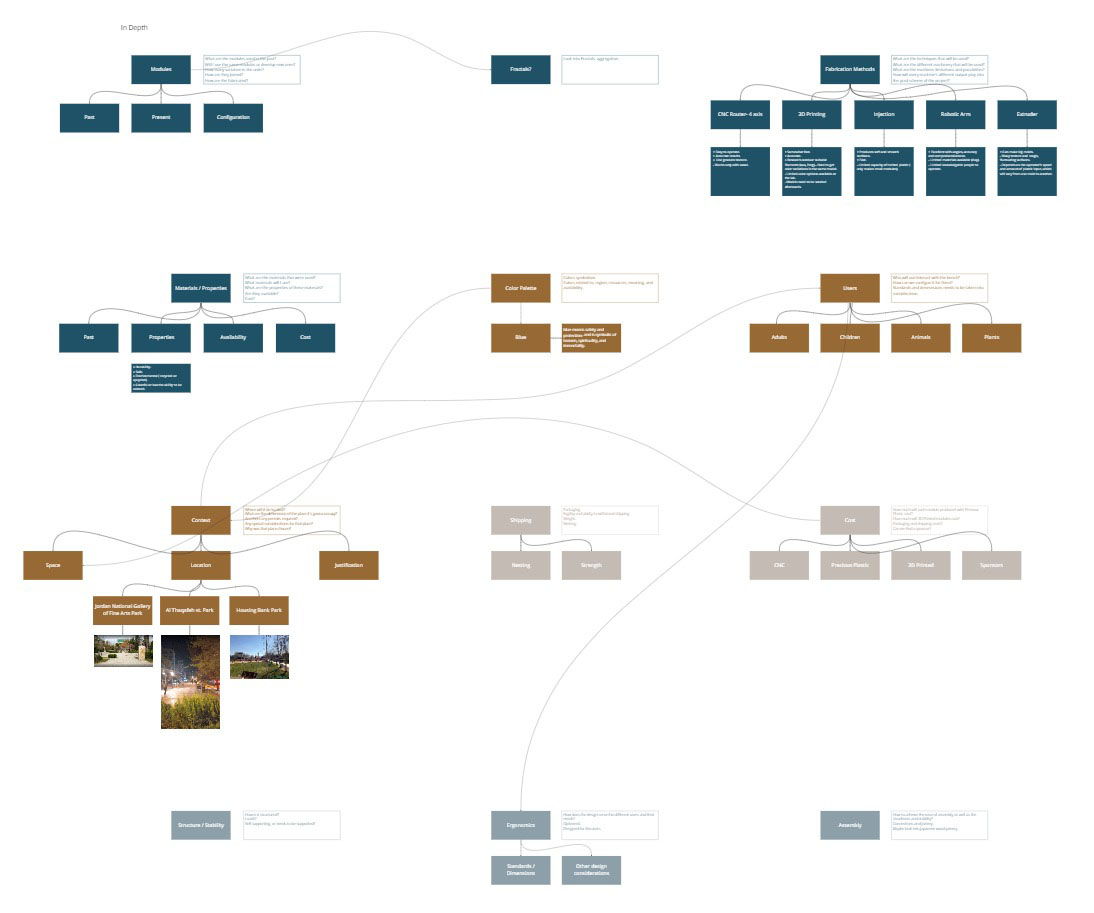




Check them out in the Miro Board below.
Moodboard¶
Here's a snippet of my mood board right now, it will be constantly updated and edited, you can see the latest version in the miro board below.

Precious Plastic Amman¶
Since I knew early on in the project that I will be collaborating with Precious Plastic, it only made sense to go and pay them a visit to better understand the machinery they have, their possibilities, and limitations.
Available Machines¶
Shredder¶
The Shredder chops the plastic into small flakes that can be used by the other machines to melt.
Extrusion¶
Shredded plastic goes in, gets molten and turns into a string of plastic. You can freestyle and wrap it around a mold or fill up molds. You can also control the speed, amount of plastic among other things.
Injection¶
Plastic melts in the barrel and is squeezed into a mold. You can make basic objects or super detailed. Works with small molds because the machine can only withhold a limited amount of melted plastic.

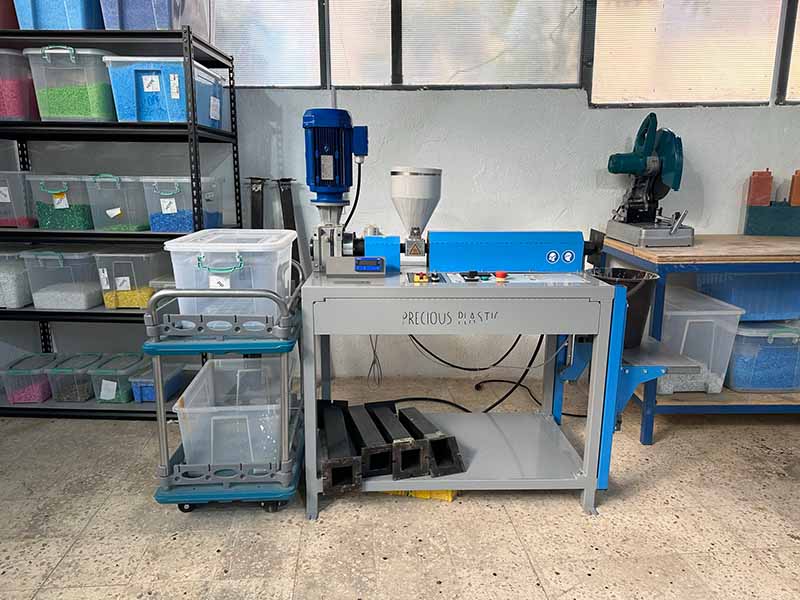
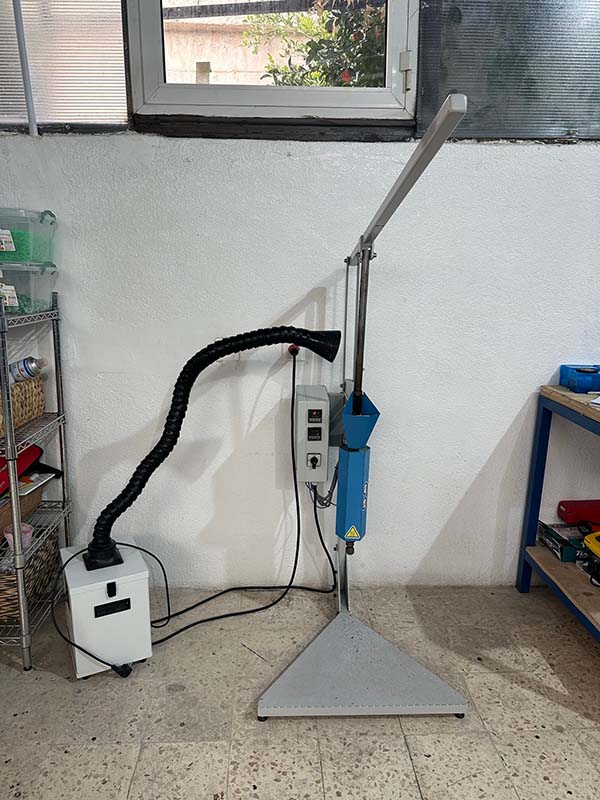
Available Materials¶
The Amman node works mostly with PP and HDPE Plastics.
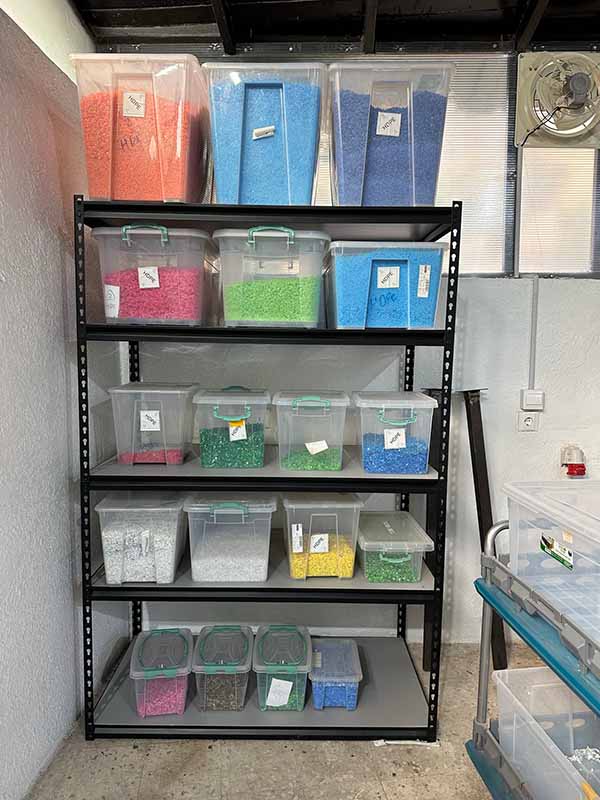
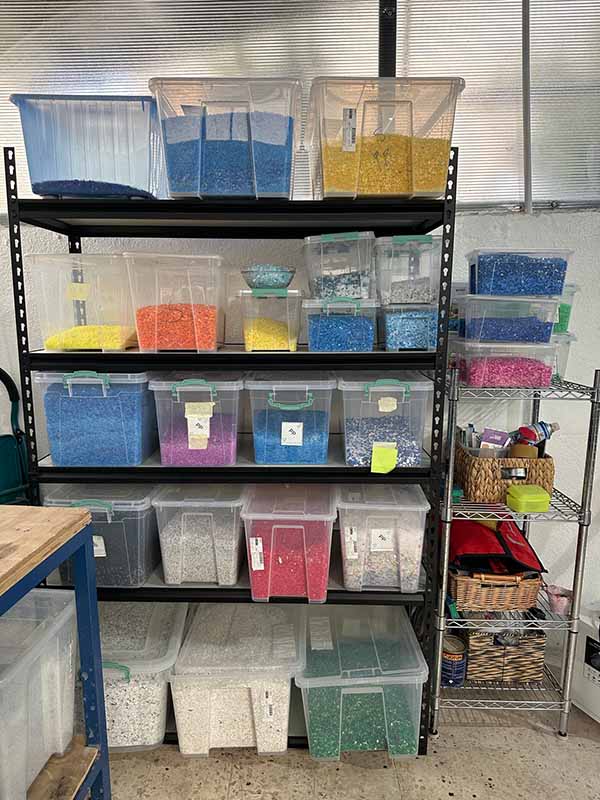
A very good and comprehensive reference and resource for Precious Plastic is their Handbook
Research¶
If you want to think outside the box, you need to understand the box and be aware of it's properties and qualities, you also need to answer what makes the box?. Only then you can deconstruct the box and come up with crazy ideas. Since my project relying heavily on an element that exist, and had its own conditions and characteristics, big chunk of my time and effort is dedicated to understanding the element, the context, and the conditions it existed in. That's the only way to develop it and move further.
In this section I will share and summarize the important takeaways from many research papers I've read and will be reading, as well as small models and prototypes I made and will be making with hand to better understand and process the topic. I should also share my thoughts and process and how they're building up.
This section will continue to evolve with time.
The Past¶
Muqarnas consists of orderly horizontal layers of small unitsurfaces, the layers are stacked one on top of another, connected via their base and top layerlines. The base layer lines of a layer and the top layer-lines of the layer below are either identical or separated by layer-joints.
Any horizontal gaps in between layer-lines of same height (like stars) are filled by roof-patches.
The Roof-patches, the unitsurfaces, and the layers are created according to a two-dimensional-pattern-plan (2DPP) with clearly defined boundaries.
The more complex the 2DPP the more complex the muqarnas.

The Two-Dimensional Pattern Plan¶
These pattern plans were regular, in many cases had multi-fold symmetry, and with a regular arrangement (liner, radial, or grid) of units, groups of units, and focal points (Yaghan, 2001. pp. 41-45).
The Units¶
The plans of these units were based on shapes of 45, 90, 135, and 67.5 degrees.
Layering¶
The three dimensional form is transformed from the two-dimensional plans. I drew a simple pattern that started with an octagon (or two squares rotated 45° from each other) and drew a set of circles, centered in the mid points of each segment and has the diameter of the segment. Then, connected the mid points of the segments with the intersection of every two adjacent circles. See the picture below for the process.

Then I worked on translating that 2D into 3D...





Evolution¶
To evolve the forms. a typology needs to be defined. That definition can happen through defining a set of qualities and then deciding what is fixed (characteristics) and what could change (attributes).
This will be further researched and decided but for now here's a mind map of the possibilities.


A Deep Dive¶
What I will present in this section is derived from A comparative analysis of the digital re-constructions of muqarnas systems: The case study of Sultanhanı muqarnas in Central Anatolia research paper by Sevde Gülizar Dinçer1 and Tuğrul Yazar2. The paper describes 3 modeling workflows for reconstructing muqarnas, one of them is the traditional one, and the other two are original contributions of the paper.
The paper also summarizes and categorizes the important research findings and studies about the topic.
Reconstructing Muqarnas Workflows¶
According to the paper mentioned above there are three different workflows to reconstruct muqarnas: - Element-based modeling. - Tessellation-based modeling. - Block-based modeling.
Element-based modeling¶
This method is the traditional one, in simple ways it's all about creating the 2D pattern plan and then moving from there to the third dimension. The 2D plan determines the units that will be used and are usually governed by mathematics and logic.
Since the paper takes one case study and analyzes it thoroughly, the units are the ones in the Sultanhani Mosque in central Anatolia. and the are the following(Dinçer & Yazar, 2021):
- Almond
- Jug
- Small Biped
- Large Biped
- Rhombus


Tessellation-based modeling¶
This method aims at creating an abstract geometric system by focusing on the tessellation found in the 2D projection of the muqarnas. It involves morphing from one source volume to the other.
The authors mention hinged tessellations, such as the Ammann-Beeker tiling , and then creating a tier system of numbering referencing every number to a level.

Block-based modeling¶
The main purpose behind this method is to create both a structural and an tectonic model. So it works in a similar way to the masonary work, the units are merged with blocks and then the blocks are stacked on top of each other.

Comparison Between Different Workflows¶
All workflows presented in the paper were evaluated in three aspects; analytical, generative, and performative. (Dinçer & Yazar, 2021)
| Workflow | Analytical | Generative | Performative |
|---|---|---|---|
| Element-based | This workflow is a generally-accepted analytical solution used in muqarnas studies. | This workflow is partially generative. It can create new designs bu has a limitation created by the strict definition of the element shapes and tiers. | This workflow ignores structural, and tectonic features of muqarnas. |
| Tessellation-based | Tessellations can open a new perspective in the analysis of muqarnas compositions. | Since this workflow uses advanced geometric transformations such as morphing, it is possible to create variations from new shapes. It has the best generative performance. | This workflow ignores historical, structural, and tectonic features of muqarnas. |
| Block-based | The blocks of the muqarnas can open a new analytical perspective in muqarnas studies. | This workflow has limited design potential. The arrangements of the blocks based on defined rules for construction. | This workflow has the best performative simulation for a defined muqarnas. It has all the muqarnas structural features. |
Next Steps¶
This page will constantly be updated, because the research will continue. Simultaneously, I will be designing and 3D modeling, you can check my progress in the Process Page
Mentoring notes¶
January 10th,2023:
The mentoring session with Nuria and Anastasia was insightful, we had a good discussion about the possibilities and the difficulties. It also raised some questions for me to keep in mind in the next few weeks, here's the summary:
Inspirational sources:
- A.Franco Studio
- 100 Architects
Questions:
- Have the molds already been done?
Progress:
- Make a fist spiral with limited Molds, materials
- Do the computational Design First
- Make a First prototype in 3D Printing
- Materials
References¶
- Dinçer, S. G., & Yazar, T. (2021). A comparative analysis of the digital re-constructions of muqarnas systems: The case study of Sultanhanı muqarnas in central Anatolia. International Journal of Architectural Computing, 19(3), 360–385. https://doi.org/10.1177/1478077121992487
- Senhaji, M., & Benslimane, R. (2019). Automatic 3D muqarnas architectural patterns reconstruction using plane representation. Journal of Cultural Heritage, 35, 25–40. https://doi.org/10.1016/j.culher.2017.12.004
- Alaçam, S., Güzelci, O. Z., Gürer, E., & Bacınoğlu, S. Z. (2017). Reconnoitring computational potentials of the vault-like forms: Thinking aloud on muqarnas tectonics. International Journal of Architectural Computing, 15(4), 285–303. https://doi.org/10.1177/1478077117735019
- Yaghan, M. A. (2005). Self-supporting “genuine” muqarnas units. Architectural Science Review, 48(3), 245–255. https://doi.org/10.3763/asre.2005.4831
- Dold-Samplonius, Y. (1992). Practical arabic mathematics: Measuring the muqarnas by al-k¯Ash¯I. Centaurus, 35(3), 193–242. https://doi.org/10.1111/j.1600-0498.1992.tb00699.x
- Yaghan, M. A. (2001). The muqarnas pre-designed erecting units: Analysis, definition of the generic set of units, and a system of unit-creation as a new evolutionary step. Architectural Science Review, 44(3), 297–318. https://doi.org/10.1080/00038628.2001.9697485